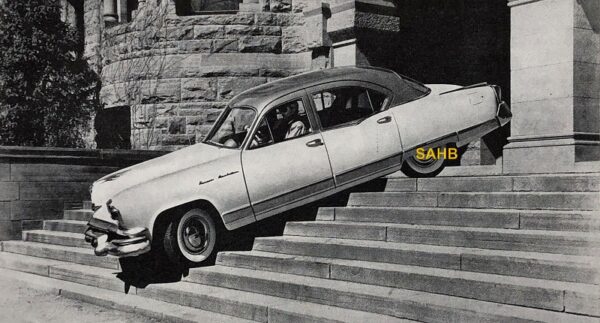
Minor American makes such as Kaiser-Frazer, up against the might of General Motors, Ford and Chrysler, had to make a splash to stand out. Driving a Kaiser Manhattan down some steps would do nicely. The aim of this stunt was to demonstrate the capability of the hydraulic power-assisted steering. The caption to the photo claimed that steps like this, eight inches high, would tear the steering wheel out of the hands of the driver in cars without this feature. This was a new option on the 1953 Manhattans, but few were so equipped.
The Manhattan models from Kaiser-Frazer were a major part of the company’s sales during 1952 and 1953. From 1947 to 1951 the premium Frazer model was the Manhattan, sold at various times in four-door sedan, hard-top or convertible versions. but Frazer cars were discontinued in 1951 and the Manhattan name was transferred to the top-of-the-range Kaiser. Because some unfinished 1951 Frazer cars remained on production lines, some of them were fitted with new serial numbers, altered bonnet decoration and optional continental spare-tyre kits and marketed as 1952 Kaiser “Virginians”.
Credit for the advanced design of what became the Kaiser Manhattan goes to Howard “Dutch” Darrin and Duncan McRae. They took on a distinctive new look, with sculptured panels and a characteristic “Darrin dip” below the rear side windows and a significantly increased amount of glass. The windscreen was steeply raked, and was dipped in the centre, adding strength to the structure and increasing glass area. And the reverse-angled rear quarter windows added dynamic tension, years before this visual trick was used in BMWs and given the name “Hofmeister kink”. There were several safety features: padded dashboards, recessed dash controls and pop-out windscreen panels. Combined with high-quality interior materials, these all made the Kaiser Manhattan a better car than many from its ‘Big-Three’ competitors.
The cars were powered by a 226.2-cu.in. (3.7-litre) straight-six engine, carried over from the earlier models. This engine, designed by Coninental, originally appeared in pre-war Grahams and was used in Willys/Jeep applications throughout the 1960s, but it also powered Massey Ferguson and Harris tractors, forklifts and some Navy bilge pumps. Replacement engine parts and rebuild kits are therefore in plentiful supply even today.
Image courtesy of The Richard Roberts Archive: www.richardrobertsarchive.org.uk







Leave a Comment